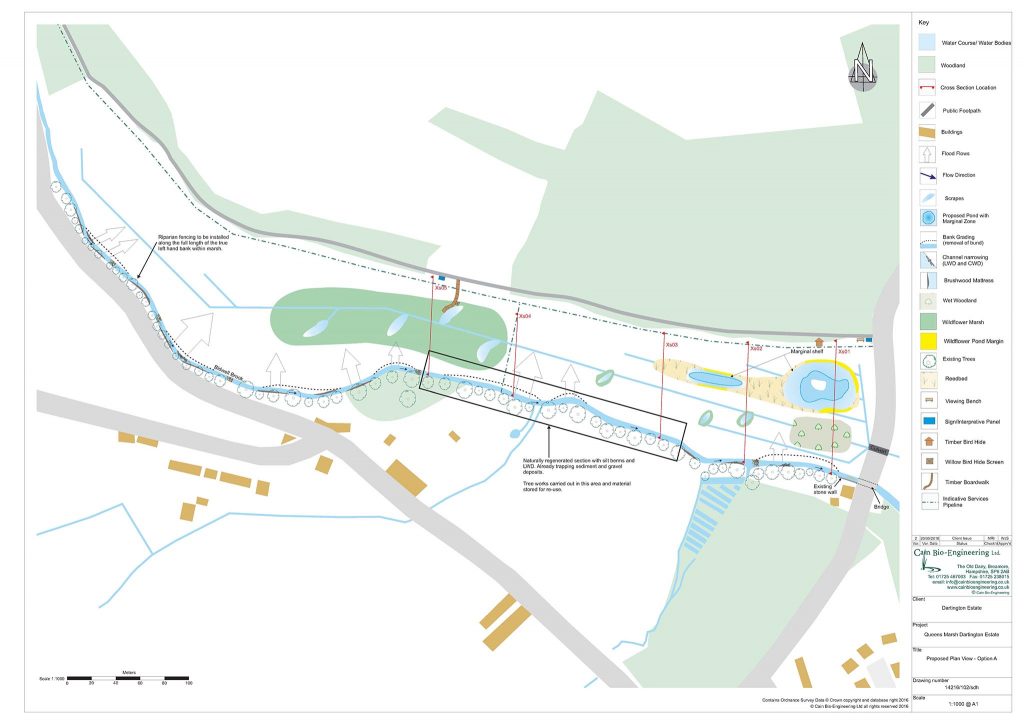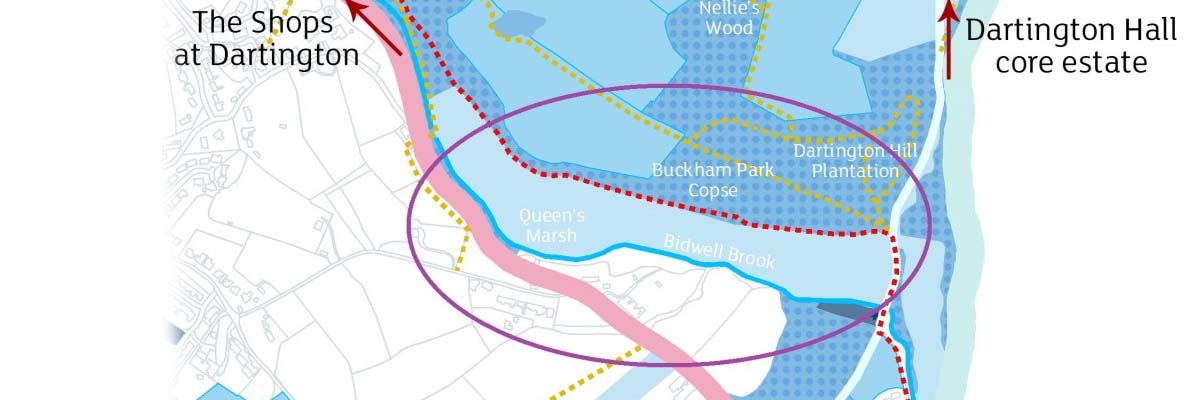Alas, the only work that went on was actually conducted by South West Water as they put a new sewage pipe across the field.
Patience is not a virtue I’ve ever been particularly blessed with but it seems to have been required learning for this summer. It also seems that patience is the partner of poverty (this is possibly a bit of an exaggeration but it is nice and alliterative).
In autumn 2015 we received the results of the feasibility study, which recommended proactively reinstating wetland habitats in Queen’s Marsh. We subsequently commissioned a Project Management plan from Cain Bio-Engineering to provide us with clarity on the costs of putting this into practice.
Specifically, we recognised that the £40k the Environment Agency (EA) had set aside for the project this year, along with the remaining £5k Dartington had available, probably would not be enough to complete the project in its entirety. So we wanted to know: ‘If we do this project to the very top specification how much is every aspect of it going to cost us?’ and also ‘Can we have it explained as individual items and a budget option that allows for flexibility in delivery and contributions of volunteer labour and work by our own staff?’

The plan concluded that if we went for the highest spec option we’ll be looking at a budget of just over £140k – that’s Option A. Option B isn’t much cheaper at £100k. Being £60/100k short we all checked down the back of our sofas but still felt we were missing rather a significant chunk of the necessary funds.
Our immediate concern was that the £40k from the EA had to be spent this year and its conditions meant that it had to achieve 7 hectares of wetland reinstatement. The challenge this presented was multiple. Firstly, £40k wasn’t going to get us far. Secondly, if it got us far enough to make the field a lot wetter throughout the year that would make putting in more features at a later date, when funding made it possible, a lot harder. Lastly, if we started work on the Marsh that would automatically invalidate us applying to a lot of other funding pots to finish the project.
The EA went off to explore if they could be more flexible in their funding and we worked out what we might be able to do in 2016, depending on various scenarios. The trouble being that, whilst there are a lot volunteers and students would help with, there are also many aspects which involve big kit and specialist knowledge.
Thankfully the EA have been able to guarantee their funding into 2017 which means we have some leeway in fundraising for the remainder. This also gives us more time to creatively think about how volunteers and students can practically help with the project.

So far we’ve had an initial application to the Biffa Award accepted and been invited to submit a full application at the beginning of December – if you like the project and would like to help support it then you can write a letter of support to be submitted alongside this funding bid, just email it to harriet.bell@dartington.org.
Of course, if you happen to find about £100k down the back of your sofa and aren’t sure what to do with it we’re happy to help.
In terms of volunteers and students being involved: when we tender the work to contractors we’ll be asking them to think about this in their delivery plans, but our own feeling is there’s probably some interesting opportunities to be creative when it comes to the interpretation element. Is there a story to be written that helps children understand the need for quiet in a bird hide? Would someone in your class be able to draw a Greater Horseshoe bat, to help explain how they’ll forage across the marsh? Whatever your ideas, we’d love to hear them.
Harriet Bell (previously food & farming manager at Dartington Hall)

Hi Harriet,
I am work at Dartington, currently with the DACs team, but I am a writer and passionate about the environment and animals. I would like a challenge and would be interested in developing a story to help in any way that would invite more local people and schools to become involved.
Hey Maxine,
Well we share a surname, a workplace and a general enthusiasm for the environment, why don’t we share a tea break one day and chat it through?
I don’t know if you can access email at work but if you can I’m harriet.bell@dartington.org or just pop over to Higher Close and come say ‘Hi’. I’ll look out for you as well when I’m around the Roundhouse or White Hart and hopefully we’ll connect.
Look forward to meeting you,
Harriet
Thanks Harriet. It was lovely to meet you the other day and I would be happy to chat further with you. I am currently having my log in details for emails ( which I knew nothing about until recently) being reset by IT.
I will get next week’s rota maybe today and will pop over or email and maybe we can sort out a time to have a cup of tea.
Looking forward to it.
Maxine
This sounds like a great project. I live in Gidleys Meadow, Dartington. Please keep me informed as to progress. I have ornithological survey skills and would be interested in being involved in monitoring the site, particularly setting up a recording system based on existing methodologies such as are promoted by the British Trust of Ornithology. This could start prior to any housing development or creation of the Queen’s Marsh wetland to provide a “before and after” record of the site’s bird life. The best time to start this, if considered a valuable contribution, would be spring 2017.
Hi Dennis,
It’s so great to hear from you and thank you for your support for the project and offer of help, we’ll absolutely take you up on it!
The estate does regular surveys, in other areas, for the BTO and we have a rich history of data but we always welcome an extra pair of hands/eyes as there’s a lot of ground to cover. Probably the best thing to do might be to register as a Volunteer here (which you can do through this website) and then you can join the rest of the Conservation Volunteers, find out what they’re already doing and work out how you can best be involved. I don’t suppose you might also be up for doing “before and after” surveys for our new agroforestry field as well would you?
Thanks,
Harriet